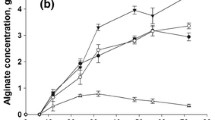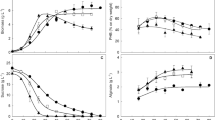Summary
The ability of alginate-entrapped microorganisms to supply oxygen was determined with regard to physiology and growth behavior of the cells. Oxygen diffusion through an alginate film containing different concentrations of Pseudomonas putida or Saccharomyces cerevisiae was measured. Oxygen diffusion decreased when the cell loading increased. Dependent on the physiological behavior of these organisms the course of the oxygen concentration under the gel film is quite different. In further experiments an “Effectiveness-Factor” of oxygen uptake of alginate beads with Saccharomyces cerevisiae or Aspergillus niger was determined in relation to the growth behavior of the organisms. The effectiveness factor is always higher when the biomass is concentrated in the outer region of the gel beads as if the microorganisms are distributed homogeneously in the alginate. Considering these results it is not possible to make a general statement on the ability of microorganisms in alginate to supply oxygen. The physiology and the growth behavior of the immobilized organisms have to be considered in any case.
Similar content being viewed by others
References
Bettmann H, Rehm H-J (1984) Degradation of phenol by polymer entrapped microorganisms. Appl Microbiol Biotechnol 20:285–290
Birkner B (1984) Sauerstoffbedarf immobilisierter Mikroorganismen. Diploma thesis, Westf. Wilhelms-Universität, D-4400 Münster
Buchholz K (1982) Reaction engineering parameters for immobilized biocatalysts. Adv Biochem Eng 24:38–71
Chang HN, Moo-Young M (1988) Estimation of oxygen penetration depth in immobilized cells. Appl Microbiol Biotechnol (in press)
Eikmeier H, Rehm H-J (1987) Stability of Ca-alginate during citric acid production of immobilized Aspergillus niger. Appl Microbiol Biotechnol 26:105–111
Eikmeier H, Westmeier F, Rehm H-J (1984) Morphological development of Aspergillus niger immobilized in Ca-alginate and χ-carrageenan. Appl Microbiol Biotechnol 19:53–57
Fujimura M, Kato J, Tosa T, Chibata J (1984) Continuous production of l-arginine using immobilized growing Serratia marcescens cells: effectiveness of supply of oxygen gas. Appl Microbiol Biotechnol 19:79–84
Gosmann B, Rehm H-J (1986) Oxygen uptake of microorganisms entrapped in Ca-alginate. Appl Microbiol Biotechnol 23:163–167
Hannoun BJM, Stephanopoulus G (1986) Diffusion coefficients of glucose and ethanol in cell-free and cell-occupied calcium-alginate membranes. Biotechnol Bioeng 28:829–835
Hiemstra H, Dijkhuizen L, Harder W (1983) Diffusion of oxygen in alginate gel related to the kinetics of methanol oxydation by immobilized Hansenula polymorpha cells. Eur J Appl Microbiol Biotechnol 18:189–196
Johansen A, Flink JM (1986) Influence of alginate properties and gel reinforcement on fermentation characteristics of immobilized yeast cells. Enzyme Microb Technol 8:737–748
Kasche V (1983) Correlation of experimental and theoretical data for artificial and natural system with immobilized biocatalysts. Enzyme Microb Technol 5:2–13
Kierstan M, Bucke C (1977) The immobilization of microbial cells, subcellular organelles, and enzymes in calcium alginate gels. Biotechnol Bioeng 19:387–397
Oosterhuis NMG, Groesbeek NM, Kossen NWF, Schenk ES (1985) Influence of dissolved oxygen concentration on the oxygen kinetics of Gluconobacter oxydans. Appl Microbiol Biotechnol 21:42–49
Radovich JM (1985) Mass transfer effects in fermentations using immobilized whole cells. Enzyme Microb Technol 7:2–10
Renneberg R, Sonomoto K, Kastoh S, Tanaka A (1988) Oxygen diffusivity of synthetic gels derived from prepolymers. Appl Microbiol Biotechnol (in press)
Ryu DD, Kim HS, Taguchi H (1984) Intrinsic fermentation kinetic parameters of immobilized yeast cells. J Ferment Technol 62:255–261
Sato K, Toda K (1983) Oxygen uptake rate of immobilized growing Candida lipolytica. J Ferment Technol 61:239–245
Shirai Y, Hashimoto K, Yamaji H, Kawahara H (1988) Oxygen uptake rate of immobilized growing hybridoma cells. Appl Microbiol Biotechnol 29:113–118
Tanaka HM, Matsumara JA, Veliky H (1984) Diffusion characteristics of substrates in Ca-alginate gel beads. Biotechnol Bioeng 26:53–58
Tramper J, Luyben KChAM, van den Tweel WJJ (1983) Kinetic aspects of glucose oxydation by Gluconobacter oxydans cells immobilized in Ca-alginate. Eur J Appl Microbiol 17:13–18
Author information
Authors and Affiliations
Rights and permissions
About this article
Cite this article
Gosmann, B., Rehm, HJ. Influence of growth behaviour and physiology of alginate-entrapped microorganisms on the oxygen consumption. Appl Microbiol Biotechnol 29, 554–559 (1988). https://doi.org/10.1007/BF00260984
Received:
Accepted:
Published:
Issue Date:
DOI: https://doi.org/10.1007/BF00260984




